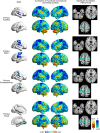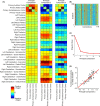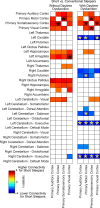Sleep duration and resting fMRI functional connectivity: examination of short sleepers with and without perceived daytime dysfunction
- PMID: 28031999
- PMCID: PMC5166999
- DOI: 10.1002/brb3.576
Sleep duration and resting fMRI functional connectivity: examination of short sleepers with and without perceived daytime dysfunction
Abstract
Background: Approximately 30% of the U.S. population reports recurrent short sleep; however, perceived sleep need varies widely among individuals. Some "habitual short sleepers" routinely sleep 4-6 hr/night without self-reported adverse consequences. Identifying neural mechanisms underlying individual differences in perceived sleep-related dysfunction has important implications for understanding associations between sleep duration and health.
Method: This study utilized data from 839 subjects of the Human Connectome Project to examine resting functional connectivity associations with self-reported short sleep duration, as well as differences between short sleepers with versus without reported dysfunction. Functional connectivity was analyzed using a parcellation covering the cortical, subcortical, and cerebellar gray matter at 5 mm resolution.
Results: Self-reported sleep duration predicts one of the primary patterns of intersubject variance in resting functional connectivity. Compared to conventional sleepers, both short sleeper subtypes exhibited resting fMRI (R-fMRI) signatures consistent with diminished wakefulness, potentially indicating inaccurate perception of functionality among those denying dysfunction. Short sleepers denying dysfunction exhibited increased connectivity between sensory cortices and bilateral amygdala and hippocampus, suggesting that efficient sleep-related memory consolidation may partly explain individual differences in perceived daytime dysfunction.
Conclusions: Overall, current findings indicate that R-fMRI investigations should include assessment of average sleep duration during the prior month. Furthermore, short sleeper subtype findings provide a candidate neural mechanism underlying differences in perceived daytime impairment associated with short sleep duration.
Keywords: environmental stimulation; fatigue; resting functional connectivity; sleep duration.
Figures






References
-
- Aeschbach, D. , Postolache, T. T. , Sher, L. , Matthews, J. R. , Jackson, M. A. , & Wehr, T. A. (2001). Evidence from the waking electroencephalogram that short sleepers live under higher homeostatic sleep pressure than long sleepers. Neuroscience, 102, 493–502. - PubMed
-
- American Academy of Sleep Medicine ed. (2014). International classification of sleep disorders, 3rd ed Darien, IL: American Academy of Sleep Medicine.
-
- Buysse, D. J. , Hall, M. L. , Strollo, P. J. , Kamarck, T. W. , Owens, J. , Lee, L. , … Matthews, K. A. (2008). Relationships between the Pittsburgh Sleep Quality Index (PSQI), Epworth Sleepiness Scale (ESS), and clinical/polysomnographic measures in a community sample. Journal of Clinical Sleep Medicine, 4, 563–571. - PMC - PubMed
Publication types
MeSH terms
Grants and funding
LinkOut - more resources
Full Text Sources
Other Literature Sources
Medical

